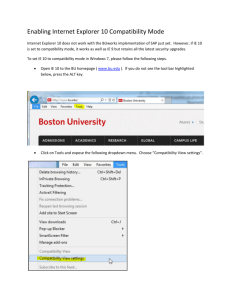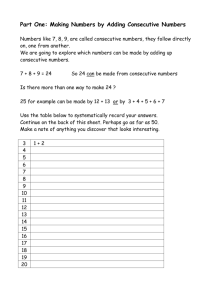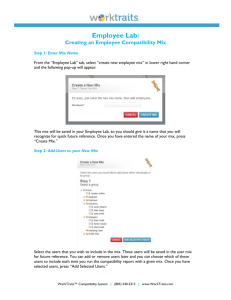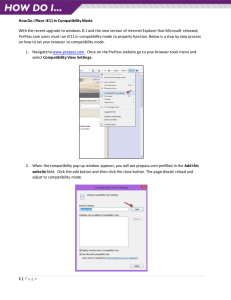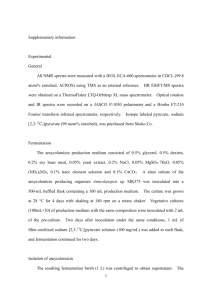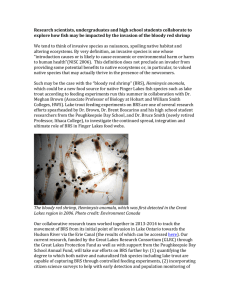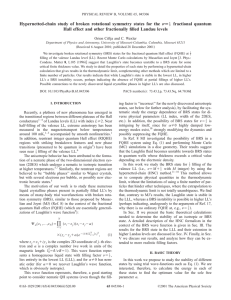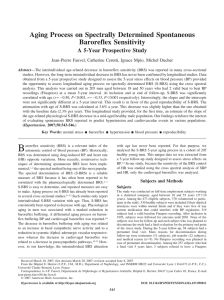Detailed Business/IT Requirements
advertisement
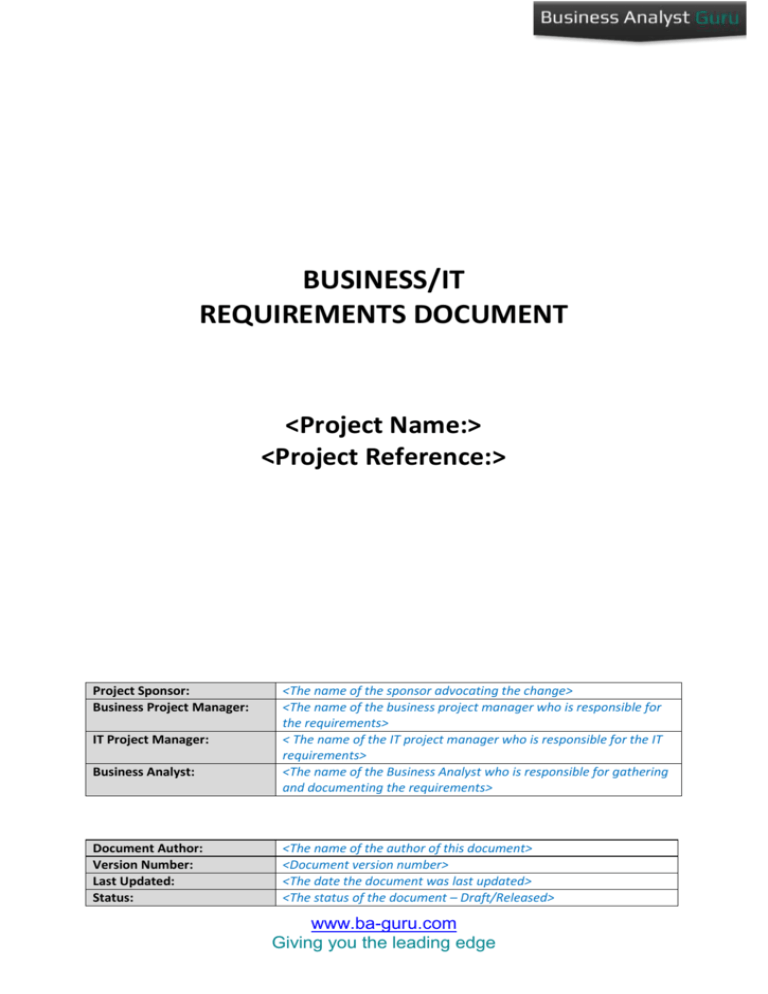
BUSINESS/IT REQUIREMENTS DOCUMENT <Project Name:> <Project Reference:> Project Sponsor: Business Project Manager: IT Project Manager: Business Analyst: Document Author: Version Number: Last Updated: Status: <The name of the sponsor advocating the change> <The name of the business project manager who is responsible for the requirements> < The name of the IT project manager who is responsible for the IT requirements> <The name of the Business Analyst who is responsible for gathering and documenting the requirements> <The name of the author of this document> <Document version number> <The date the document was last updated> <The status of the document – Draft/Released> www.ba-guru.com Giving you the leading edge <Project Title> DOCUMENT CONTROL <Blue italic text is included to provide guidance to the author and should be deleted before publishing> Contacts <Contacts that would be useful to provide for business information> Name: Title: Location: Contact Number: Email: <Contact name> <Contact title> <Where the contact can be located> <Contact internal/external number> < The email correspondence for the contact> Document Approval <Enter details of all stakeholders who will be subject to approval of this document> Approver Title Business Area Approval Date Document Distribution <Enter details of all stakeholders who will be subject to receipt of this document for reference purposes> Name Title Business Area Revision History <Initially a document will be numbered 0.1 to 0.9 until it becomes the first issue for approval at which point the document is numbered 1.0. For future updates the document will be numbered using decimals to 1 place until it adopts the next whole number for issue> Date Author Version Summary Of Changes Status Related Documents <List any significant documents that precede and relate to the project> Document Name Version Author Status: <Draft/Released For Approval/Approved> www.ba-guru.com Giving you the leading edge Date Page 2 of 13 <Project Title> <Not all of the following sections may be applicable to the work being performed. If so, the preference would be to keep the section heading, but make a note such as “This section is not applicable for this process” and provide an explanation for the reasons why> Status: <Draft/Released For Approval/Approved> www.ba-guru.com Giving you the leading edge Page 3 of 13 <Project Title> Table of Contents 1 Introduction ..................................................................................................................................... 5 2 Problem/Impact/Successful Outcome............................................................................................. 5 3 Objectives ........................................................................................................................................ 5 4 Purpose Of Document ..................................................................................................................... 5 5 Scope ............................................................................................................................................... 5 6 Definitions, Acronyms and Abbreviations ....................................................................................... 6 7 Risks ................................................................................................................................................. 6 8 Assumptions .................................................................................................................................... 6 9 Issues ............................................................................................................................................... 6 10 Dependencies............................................................................................................................... 6 11 As Is Process ................................................................................................................................. 7 12 Context Diagram .......................................................................................................................... 7 13 Process Overview Diagram .......................................................................................................... 7 14 High Level To Be Business Requirements .................................................................................... 7 15 Detailed Business/IT Requirements ............................................................................................. 8 15.1 Functional Requirements ......................................................................................................... 8 15.2 Process Diagram ....................................................................................................................... 9 15.3 Non Functional Requirements.................................................................................................. 9 16 Costs ........................................................................................................................................... 13 17 Appendices ................................................................................................................................. 13 Status: <Draft/Released For Approval/Approved> Page 4 of 13 <Project Title> 1 Introduction <This should be a high level introduction and background to the Project> 2 Problem/Impact/Successful Outcome The Problem <Detail the problem/issue which requires a resolution> 3 The Impact <Detail the impact of the problem upon the business community, application or process> The Successful Outcome <Detail, at high level, what successful outcome would provide a resolution to the problem> Objectives <State the objectives to be met by the business solution. The ID number will take the form of Oxx where xx = a consecutive number per entry> ID Oxx 4 Business Objective Business Owner Business Importance Purpose Of Document The Business Requirements Specification details the business requirements as elicited by the business analyst from the key stakeholders. The document presents the requirements in a structured way that facilitates review and sign off by the designated approvers. Building on the high level scope of the project as defined in the Project Definition Document, the business requirements clearly state in business language what any chosen solution must do. This document captures the business requirements in a structured way, providing the basis for ensuring that the solution delivered meets the requirements. It should: Facilitate a shared understanding for all stakeholders of the business requirements Be the key input for the preparation of a functional requirements specification Facilitate the identification of possible solutions 5 Scope In Scope <A brief description or bullet points of what is in scope> Status: <Draft/Released For Approval/Approved> Out Of Scope <A brief description or bullet points of what is out of scope> Page 5 of 13 <Project Title> 6 Definitions, Acronyms and Abbreviations <This subsection provides the definitions of all terms, acronyms, and abbreviations required to properly interpret the BRS> Abbreviation/Acronym 7 Description Risks <Insert details of any risks you forsee in being able to complete the requirements. The ID number will take the form of Rxx where xx = a consecutive number per entry > Ref Rxx 8 Risk Detailed BRS Reference Assumptions <Insert details of any assumptions made during elicitation of the requirements. The ID number will take the form of Axx where xx = a consecutive number per entry> Ref Axx 9 Assumption Detailed BRS Reference Issues <Insert details of any issues which contribute to the requirements being incomplete. The ID number will take the form of Ixx where xx = a consecutive number per entry> Ref Ixx Issue Detailed BRS Reference 10 Dependencies <Insert details of any dependencies for the requirements to be completed. The ID number will take the form of Dxx where xx = a consecutive number per entry> Ref Dxx Dependency Status: <Draft/Released For Approval/Approved> Detailed BRS Reference Page 6 of 13 <Project Title> 11 As Is Process < Detail, at high level, the current As Is process. Include a process flow diagram if required. The As Is process may already have been documented separately. Make reference to this within the Related Documents section > 12 Context Diagram <This is a diagram that details how and where the new process to be defined sits within the overall E2E business process and illustrates the relationship among actors, processes and information. Define clearly in which part of the process the changes will take place. If the requirements are a component of a larger system, detail this within the diagram. This may take the form of a mind map, process flow or any other notation which suits the business/author > 13 Process Overview Diagram <Add a high level process flow diagram of the E2E business process to which this requirements document relates> 14 High Level To Be Business Requirements < Detail, at high level, the To Be business requirements> Status: <Draft/Released For Approval/Approved> Page 7 of 13 <Project Title> 15 Detailed Business/IT Requirements 15.1 Functional Requirements <List the functional requirements which will deliver the business/IT requirements> ID Title FRxxx Requirements Description Type (*) MoSCoW Priority Originator Status (**) Delivered By Test ID * Type Key: Business Application Information Integration Technical ** Status Key: Proposed Accepted MoSCoW Rating: Must Have: Describes a requirement that must be satisfied in the final solution for the solution to be considered a success Should Have: Represents a high-priority item that should be included in the solution if it is possible. This is often a critical requirement but one which can be satisfied in other ways if strictly necessary. Could Have: Describes a requirement which is considered desirable but not necessary. This will be included if time and resources permit. Would Have: Represents a requirement that stakeholders have agreed will not be implemented in a given release, but may be considered Status: <Draft/Released For Approval/Approved> Page 8 of 13 <Project Title> 15.2 Process Diagram <Include a process flow diagram which links to the functional requirements above if necessary> 15.3 Non Functional Requirements <List the non-functional requirements which will deliver the business/IT requirements> ID Title NFRxxx Requirements Description Type (*) MoSCoW Priority * Type Key: Technical Integration Security Audit Performance Capacity Availability Reliability Recovery Compatibility Maintainability Usability ** Status Key: Proposed Accepted Status: <Draft/Released For Approval/Approved> Page 9 of 13 Originator Status (**) Delivered By Test ID <Project Title> <Non Functional requirements checklist:- TYPE SECURITY Login Requirements Password Requirements Inactivity Timeouts AUDIT Audited Elements Audited Fields Audit File Characteristics PEFORMANCE Response Times Processing Times Query & Reporting Times CAPACITY Throughput Storage Year on year growth requirements AVAILABILITY Hours of Operation Locations of Operation RELIABILITY Meantime Between Failures Meantime To Recovery INTEGRITY Fault Trapping Bad Data Trapping Data Integrity Image Compression & Decompression Standards RECOVERY Recovery process Recovery Timescales Backup Frequencies Backup Generations COMPATIBILITY Compatibility With Shared Application Compatibility With 3rd Party Applications Compatibility On Different Operating Systems SAMPLE DETAIL Access levels, CRUD levels (Create/Retrieve/Update/Delete) Length, special characters, expiry, recycling policies Durations, actions What business elements will be audited Which data fields will be audited Before image, after image, user & time stamp Application loading, screen open & refresh times Functions, calculations, imports, exports Initial loads & subsequent loads How many transactions per hour does the system need to be able to handle? How much data does the system need to be able to store? When is it available? Consider weekends, holidays, maintenance times etc Where should it be available from; what are the connection requirements? What is the acceptable threshold for down-time eg. one a year, 4,000 hours etc If broken, how much time is available to get the system back up again? How to handle electronic interface failures Data imports; flag-and-continue or stop the import policies etc Referential integrity in DB tables and interfaces How do recoveries work; what is the process? How long should a recovery take to perform? How often is the transaction data, set-up data and system (code) backed up? What are the requirements for restoring to previous instance(s)? What other systems does it need to talk to? What other systems does it have to live with amicably? What does it have to be able to run on? Status: <Draft/Released For Approval/Approved> Page 10 of 13 <Project Title> Compatibility On Different Platforms? MAINTAINABILITY Conformance to Architecture Standards Conformance to Design Standards Conformance to Coding Standards USABILITY Look And Feel Standards Internationalization/ Localization Requirements What are the hardware platforms it needs to work on? What are the standards it needs to conform to or have exclusions from? What design standards must be adhered to or exclusions created? What design standards must be adhered to or exclusions created? Screen element density, layout and flow, colours, UI, metaphors, keyboards and shortcuts Languages, spellings, keyboards, paper sizes etc Status: <Draft/Released For Approval/Approved> Page 11 of 13 <Project Title> 16 Business Impact Assessment Lens Process People Customer Financial Data & MI Product & Proposition Supplier Management Governance & Risk Key Impacts Impacts on business process and to what extent Introduction of any automation to business processes and if so has the business/cost model been reviewed to reflect this Have any new/amended policies been introduced New/revised organisation design impacts including resource impacts and if applicable recruitment needs Training and development requirements Additional cultural change requirements Communication requirements Customer communication requirements before, during and after Impacts on customer experience if everything goes according to plan Impacts on customer experience if things do not go according to plan and mitigation requirements Operational cost impacts, e.g. licenses and ongoing support/maintenance Benefits management processes in place Data cleanse requirements/approach Data governance/policy requirements Data migration requirements Data access requirements MI/reporting requirements Change to existing products as a result of this change New product development Product governance requirements, e.g. product implementation group Customer needs understood/documented Existing contract impacts, e.g. re-negotiation, rights to use New contract impacts Supplier communication requirements Supplier interface/governance/data impacts Business readiness management requirements Business readiness plan requirements Stakeholder engagement/communication requirements Operational risk impacts and where appropriate mitigation requirements Risk and control framework impacts, e.g. changes to control owners Regulatory compliance impacts and documentation/evidence of obligations met New/revised governance Status: <Draft/Released For Approval/Approved> Page 12 of 13 <Project Title> 17 Costs <Include any costs associated with this change if applicable. Note: This section has been specifically added at the request of the Food Business Analysts> 18 Appendices <Additional document/s to add as a reference to the requirements> Status: <Draft/Released For Approval/Approved> Page 13 of 13
